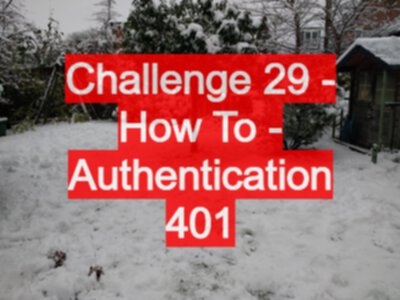This post and video shows how to complete the authentication failed with username and password challenge number 29, which returns a status code of 401.
What are the API Challenges?
Our API Challenges Application has a fully functional cloud hosted API, and a set of challenges to work through.
Authentication Challenge
Most of the challenges simply require the correct payload, and an X-Challenger header to track the session. The authentication challenges require an extra header, the value for which can only be obtained with a username and password.
Challenge 29 Authentication Failed
Issue a POST request on the
/secret/tokenend point and receive 401 when Basic auth username/password is not admin/password
POSTrequest means use the HTTP Verb POST- e.g.
POST /secret/tokensends to the secret token endpoint
- e.g.
Basic authmeans include the Basic Authorization headerusername/password is not admin/passwordthe authorisation header value is base 64 encoded, and the details should not matchadminas the username, andpasswordfor the password- add the
X-CHALLENGERheader to track progress and because the authentication code we need is asociated with theX-challengersession - Receive a 401 response
Basic Instructions
- Create a new request for the
/secret/tokenend point- if running locally that endpoint would be
http://localhost:4567/secret/token
- if running in the cloud that endpoint would be
https://apichallenges.herokuapp.com/secret/token
- if running locally that endpoint would be
- The verb should be a
POST - Add a Basic Auth header by selecting “Basic” from the “Auth” tab and entering a username and password but make sure it is not admin/password e.g. use username “Admin1”, password “Pa55word” (or anything else you want)
- There should be no payload in the message
- You should receive a 401 response - meaning “Unauthorized” because you entered the wrong username or password
- The request should have an
X-CHALLENGERheader to track challenge completion
> POST /secret/token HTTP/1.1
> Host: apichallenges.herokuapp.com
> User-Agent: insomnia/2021.2.2
> X-CHALLENGER: x-challenger-guid
> Authorization: Basic YWRtaW46cGFzc3dvcmRk
> Accept: */*
> Content-Length: 0
< HTTP/1.1 401 Unauthorized
< Connection: close
< Date: Sat, 24 Jul 2021 11:13:04 GMT
< Www-Authenticate: Basic realm="User Visible Realm"
< Access-Control-Allow-Origin: *
< Access-Control-Allow-Headers: *
< X-Challenger: x-challenger-guid
< Content-Type: text/html;charset=utf-8
< Server: Jetty(9.4.z-SNAPSHOT)
< Via: 1.1 vegur
Note that the Authorization header does not send the username and password in plain text, it uses Base64 to obscure the details.
You could see what username and password I used by typing the Base64 string YWRtaW46cGFzc3dvcmRk into a Base64 decoder like https://www.base64decode.org/
Or you could decode it in the browser dev console by typing:
atob('YWRtaW46cGFzc3dvcmRk')
The command to encode a string as base64 is btoa
Note also that although we add an “Authorization” header, really we are trying to “authenticate” with a set of user details.
- Authorization is “do you have the right permissions”
- Authentication is “are you who you say you are”
Extras
- try creating a base64 Authorization header by hand, without using the “Auth” tab in Insomnia







